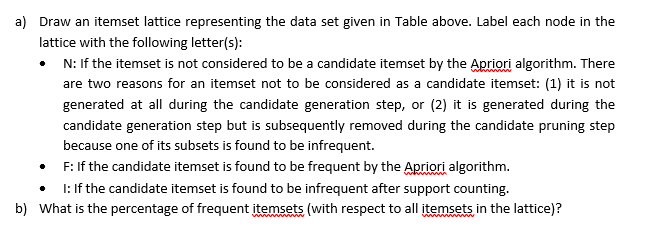Answered step by step
Verified Expert Solution
Question
1 Approved Answer
Please do part A, B, C, D with Frequent Pattern(FP) Algorithm The Apriori algorithm uses a generate-and-count strategy for deriving frequent item sets. Candidate item



Please do part A, B, C, D with Frequent Pattern(FP) Algorithm
The Apriori algorithm uses a generate-and-count strategy for deriving frequent item sets. Candidate item sets of size k + 1 are created by joining a pair of frequent item sets of size k (this is known as the candidate generation step). A candidate is discarded if any one of its subsets is found to be infrequent during the candidate pruning step. Suppose the Apriori algorithm is applied to the data set shown in Table below with minsup = 30%, i.e., any itemset occurring in less than 3 transactions is considered to be infrequent. Transaction ID Items Bought 1 {a,b,d,e} 2 {b,c,d) 3 {a,b,d,e) 4 {a,c,d,e) {b,c,d,e} 6 {b,d,e} 7 (c,d) 8 {a,b,c} 9 {a,d,e} 10 {b, d) 5 a) Draw an itemset lattice representing the data set given in Table above. Label each node in the lattice with the following letter(s): N: If the itemset is not considered to be a candidate itemset by the Apriori algorithm. There are two reasons for an itemset not to be considered as a candidate itemset: (1) it is not generated at all during the candidate generation step, or (2) it is generated during the candidate generation step but is subsequently removed during the candidate pruning step because one of its subsets is found to be infrequent. F: If the candidate itemset is found to be frequent by the Apriori algorithm. I: If the candidate itemset is found to be infrequent after support counting. b) What is the percentage of frequent itemsets (with respect to all itemsets in the lattice)? c) What is the pruning ratio of the Apriori algorithm on this data set? (Pruning ratio is defined as the percentage of itemsets not considered to be a candidate because (1) they are not generated during candidate generation or (2) they are pruned during the candidate pruning step.) d) What is the false alarm rate (ie, percentage of candidate itemsets that are found to be infrequent after performing support counting)Step by Step Solution
There are 3 Steps involved in it
Step: 1

Get Instant Access to Expert-Tailored Solutions
See step-by-step solutions with expert insights and AI powered tools for academic success
Step: 2

Step: 3

Ace Your Homework with AI
Get the answers you need in no time with our AI-driven, step-by-step assistance
Get Started


